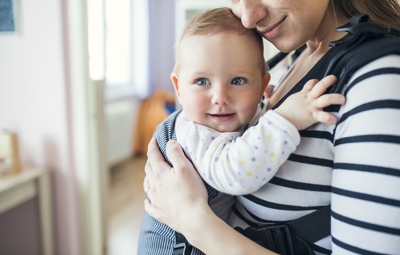 Baby slings and carriers are a fantastic way of moving about with your baby, keeping them close to you, and ensuring that they are safe, contented, and secure. However, over the past few years, there have been a few safety concerns raised about slings and carriers and this has led to some parents being scared to use them. However, the fact is that if you buy a good quality baby carrier or sling from a reputable shop or online store, and most importantly use it exactly as the manufacturer’s instructions dictate, you should have no problem.
Baby slings and carriers are a fantastic way of moving about with your baby, keeping them close to you, and ensuring that they are safe, contented, and secure. However, over the past few years, there have been a few safety concerns raised about slings and carriers and this has led to some parents being scared to use them. However, the fact is that if you buy a good quality baby carrier or sling from a reputable shop or online store, and most importantly use it exactly as the manufacturer’s instructions dictate, you should have no problem.
TICKS Checklist
The British Association of Babywearing Instructors recommend the ‘TICKS’ checklist, developed by the Consortium of UK Sling Manufacturers and Retailers:
- Tight
- In view at all times
- Close enough to kiss
- Keep chin off chest
- Supported back
T – Tight: Your carrier should be tight and be tight enough to hold your baby close to you comfortably. If it is too slack, it will allow your baby to slump in the carrier, which can then hamper their breathing.
I – In view at all times: If you cannot see your baby’s face at all times when glancing down then you are wearing your baby carrier or sling incorrectly and this could lead to problems. If you’re wearing a back carrier, this may not be as important as they are generally used for older, more independent children.
C – Close enough to kiss: Your baby should be close enough to comfortably kiss them easily by tipping your head forward. If they’re not, your sling is not fitted correctly and you should not use it until this has been rectified.
K – Keep the chin off the chest: Your baby should never be curled in your sling or carrier as that forces their chin onto their chest. If this is the case, it could restrict their breathing, which is obviously a big danger.
S – Supported back: In cradle-carry type slings, your baby should be positioned with their bottom at the deepest part of the sling which helps to support their back and should prevent their chin touching their chest. In a more structured upright front or back carrier, your baby should be held comfortably and close to the wearer with their back supported in a natural position.
Other Baby Sling and Baby Carrier Safety Tips
- Back carriers should only be used once your baby can sit up comfortably on their own.
- Always abide by the manufacturer’s instructions regarding use and the suitable size and age limits for each sling.
- Avoid bag slings for small babies, as they can out them in a dangerous ‘chin to chest’ position, which potentially could lead to suffocation.
- Avoid carrying young babes in front facing front carriers, as it forces your baby’s back to be straight against your chest, which rests all of their weight on their crotch, making for an uncomfortable journey.
- If in doubt about anything safety wise, do not use your carrier or sling and consult your health visitor, GP or a recognised expert.